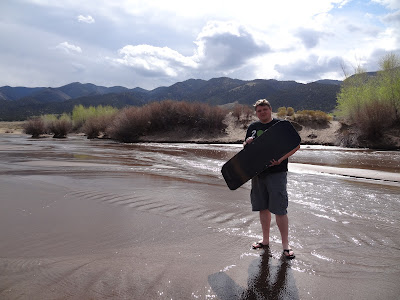Visited: May 2017
Nearby town: Alamosa, CO
"Their appearance was exactly that of the sea in a storm, except as to color, not the least sign of vegetation existing thereon."
-explorer Zebulon Pike, upon his first glimpse of the dunes in 1807
In a remote area of south-central Colorado lies one of the more unexpected sights in nature. A large collection of barren sand dunes lies at the base of incredibly high snow-capped mountains. The contrast created by the sand and the snow make for an awe inspiring vista.
The Great Sand Dunes of Colorado are the largest and tallest sand dunes in all of North America. The tallest dune in the park, Star Dune, is over 750 ft tall. The dunes lie in the arid plains of the San Luis Valley, wedged between the Sangre de Cristo Mountains on the east and the San Juan Mountains to the west. The creation of the dunes is a story of wind and water. The San Luis Valley used to be covered by a lake that disappeared millennia ago, leaving copious amounts of sand that once lied on the lake bed. There are still a number of seasonal lakes and rivers in the valley that evaporate in the warm months, also leaving a lot of sand exposed to the elements. The harsh winds pick up the sand and deposit it at the base of the impassable mountains.
There are a few trails that head up to the forested slopes of the Sangre de Cristo Mountains. But the dunes are of course the highlight and main attraction of the Park. Right before the Park entrance is a store where you can rent sand boards and sand sleds for the day. They'll give you a brief rundown on how to use them, and then you can play and slide down the dunes to your heart's content. Tara got in some good slides...I couldn't quite get the hang of it. 😊
 |
| Tara at the top... |
 |
| Tara at the bottom. |
 |
| after another somewhat failed attempt 😖 |
 |
| surf's up! |
It's pretty tough trudging through the dunes. So when hiking up the dunes, stay on the ridges. Also make sure you're wearing some good footwear especially in the summer months, the dunes can get very hot!
Another highlight of the Park is Medano Creek, which flows March - May. The river usually dries up completely by late May/early June. It's a very shallow river that runs along the dunes. It's a great way to cool off after sledding for a few hours. Wading in the river was a delight, you can also float down in a tube if the current is strong.
Great Sand Dunes is an easy park to explore in a day, but it is very remote. The scenery is very enchanting. If you want to spend more time in the dunes and the mountains, there is a campground. For more info: https://www.nps.gov/grsa/index.htm.




























































